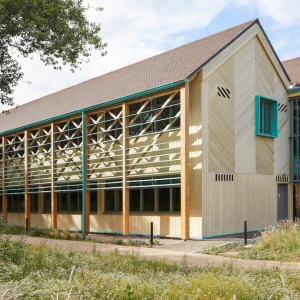The Mary Rose Museum will permanently house the hull of the Mary Rose – Henry VIII’s flagship – which was raised from the seabed of The Solent near Portsmouth in 1982. It is located within the Portsmouth Historic Dockyard – from where the ship was launched – and joins The National Museum of The Royal Navy and The Victory at the site.
Pringle Brandon has designed the interiors of the museum. The design takes an ‘inside-out’ approach, cradling the hull at the centre of the new museum alongside a virtual hull which will display the original artefacts in context.
A new visitor attraction has been designed around the hulk of the Mary Rose, which will be displayed in an ‘air-lock’ controlled environment. Visitors will be able to observe the ship’s hull, and a treasure trove of exhumed 16th century artifacts through a series of windows. The windows will be removed after a drying process that is expected to take around four to five years.
Land Design Studio has designed the exhibition work featuring an immersive audio-visual experience to greet visitors, which will tell the story of the ship’s final moments. A ‘contextual gallery’ has been created which will showcase ‘a facsimilie of volumetric spaces’ displaying artifacts. Deck galleries will run the length of the ship, corresponding to the original deck levels and leading to further gallery space at the end of the dry dock. Two ends of the gallery will use screen-based media and displays to introduce historical characters on the ship, including a gunner, cook, carpenter and naval officer, along with personal belongings.
Visitors will also get the opportunity to handle replica weapons and learn about the physical effects of pulling a longbow, which can be seen, marked on the bones of an archer. The bones of Hatch, the ships dog have also been preserved. DNA research, reconstruction and human remains will be used to build up a picture of life on board the ship.
A painting of the ship’s final moments has been developed into a projection developed by Spiral. It has been embedded with stories, which come to life as an interactive mapping device, accessed from workstations. The museum will also showcase the ship’s story in the context of Portsmouth, including how its 500 crew lived locally, and how King Henry VIII watched the ship sink from his vantage point at Southsea Castle.
The new building is roofed by a low shell structure that has been prefabricated and lifted into place over the existing ship hall.





